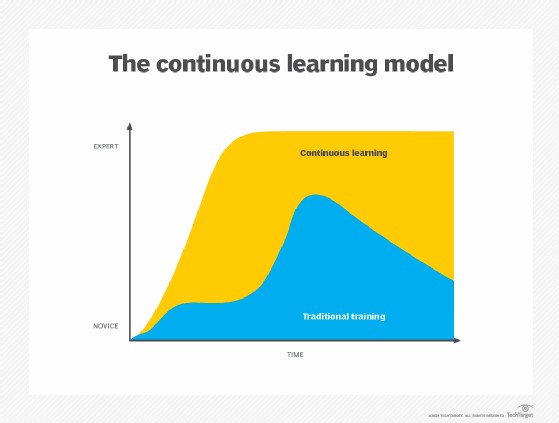Continuous learning is the ongoing process of expanding one’s knowledge and skills. In a professional context, it involves developing new competencies while reinforcing existing ones. This process can be formal or informal, structured or unstructured, encompassing activities like taking courses, observing experienced colleagues, seeking assistance, exploring new work methods, studying, and practicing skills. Daily habits and practices form the foundation of continuous learning, facilitating knowledge intake throughout life.
Continuous learning contrasts with traditional training; knowledge is retained at a higher level through consistent reinforcement and multiple learning events, leading to sustained competency.
Principles of Continuous Learning for Lasting Benefits
Traditional training often results in a peak of knowledge immediately after a course, followed by a gradual decline due to lack of reinforcement. Continuous learning combats this by providing ongoing opportunities for knowledge application and skill development. Key elements of a continuous learning environment include readily accessible learning resources, opportunities for practical application, a culture that fosters learning, collaboration platforms, and regular feedback mechanisms.
Reaping the Rewards: Benefits of Continuous Learning
Continuous learning offers significant advantages for both individuals and organizations.
Individual Benefits:
- Career Advancement: Continuous learning helps individuals achieve their career goals by equipping them with the necessary skills and knowledge for promotions and new opportunities.
- Professional Development: Obtaining and updating professional licenses or certifications enhances credibility and expertise.
- Expanded Horizons: Exploring new perspectives fosters personal and professional growth.
- Marketable Skills: Upskilling and reskilling equip individuals with in-demand competencies, increasing their value in the job market.
Organizational Benefits:
- Goal Achievement: A skilled workforce contributes directly to achieving organizational objectives.
- Innovation Culture: Continuous learning fosters a forward-thinking environment that encourages new ideas and solutions.
- Employee Value: Investing in employee development demonstrates a commitment to their growth, boosting morale and retention.
- Cost Savings: Developing existing employees is often more cost-effective than hiring and training new personnel.
- Competitive Edge: A highly skilled and adaptable workforce enhances an organization’s ability to compete in a dynamic market.
Overcoming Obstacles: Challenges of Continuous Learning
While continuous learning offers significant benefits, it also presents challenges:
- Resistance to Change: Employees may resist learning new skills if they perceive them as uninteresting or difficult. Alternative training methods and engaging content can address this.
- Evolving Needs: Rapidly changing business requirements may render newly acquired skills obsolete. Agile learning approaches and focusing on foundational skills can mitigate this.
- Time Constraints: Employees may struggle to find time for training. Bite-sized learning modules and flexible schedules can improve accessibility.
- Budget Limitations: Limited training budgets may restrict access to high-quality resources. Leveraging free or low-cost resources and prioritizing training investments can help.
- Lack of Personalization: Generic training programs may not cater to individual learning styles. Personalized learning paths and diverse learning resources can address this.
Building a Thriving Culture of Continuous Learning
A successful continuous learning strategy requires a supportive environment cultivated by leadership, careful planning, and sustainable resources. Organizations can encourage continuous learning by:
- Strategic Planning: Develop a clear roadmap outlining learning goals, target audience, and resource allocation.
- Leadership Support: Demonstrate commitment to continuous learning from the top down, fostering a culture of growth and development.
- Sustainable Resources: Provide ongoing access to learning platforms, tools, and mentorship opportunities.
Continuous Learning: A Key to Individual and Organizational Success
Continuous learning is not merely a trend but a necessity in today’s rapidly evolving world. By embracing a culture of continuous learning, individuals and organizations can unlock their full potential, adapt to change, and thrive in the face of new challenges. From structured courses to self-directed learning and social interaction, the avenues for continuous learning are vast and the benefits are undeniable.
